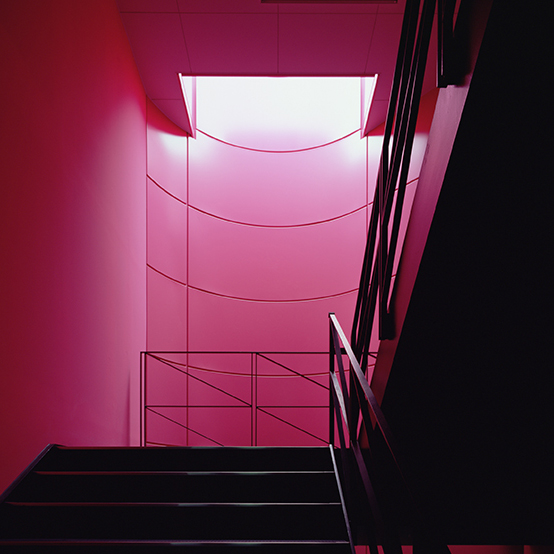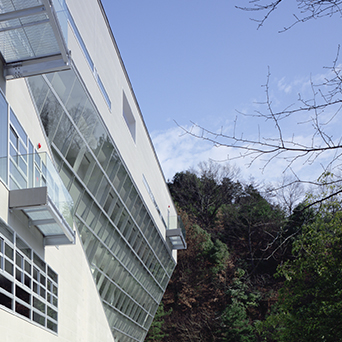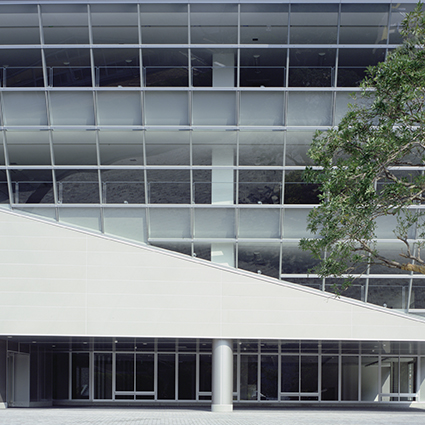- principal use : administrative office, partially lecture rooms
- size: 6,468 m2/total floor area 144,755 m2/site area
- number of stories: 5stories
- structure: steel structure
- building site: Kyoto, JAPAN
- client: Kyoto Seika University
- design period: Oct.2007 ~ Feb.2008
- construction period: May 2008 ~ Mar.2009
- architect: Kyoto Seika University Suzuki Studio + Suzuki Design Networks
- structual engineer: Sumitomo Mitsui Construction Co.
- contractor: Sumitomo Mitsui Construction Co.
- photographer: Ryota ATARASHI
空 Emptiness or Sky 【kuː or sora】
"At the beginning, 空 exists.
Architecture would be built to cause the emergence of the 空 as the visible".
This is the "plot" that I first wrote for this architecture。
Kyoto Seika University was established in 1968.
It was a small school that had only about 200 students.
But now has grown up to have over 4,000 students in 4 faculties, Art, Design, Manga, and Humanities.
The main building as a head office, which was built at the early stage of the history, became old and too small to administrate this university.
In 2007, we began to plan a new main building, also as an event for 40th anniversary.
People would see a main building as a "face" of the university.
They, who come to this campus, must meet this face at first.
So I thought I should design the expression of the face.
People, who will be invited by this expression to enter the building,
should have an experience through the story of space.
The expression and the experience became main theme for me to design it.
I would design the expression not with arbitrary way but with the environment.
I tried to draw many lines according to the surroundings of the site and then make the shape by connecting the crossing points made by these lines.
You may suppose I drew the first line according to the landscape or circulation,
but I didn't so.
The first line that I drew was for dragging sky into the building.
These lines made a void shaped as a big tower.
This void has no scenery but only a vision of the sky.
It has no function. It's just tower showing us the emptiness.
Surrounding the emptiness, many lines were drawn to make the shape of the building.
A huge triangle emerged as the façade. I designed with glasses so that people can see the inside of the building and also the landscape reflected on it.
It would be the expression of the "face" that people may first meet.
People will enter the building with invited by the expression and have a vision of the sky.
Then, they may go upstairs to seize the sky.
Staircases are colored red or blue with the light from the sky. When they reach the highest floor,
they would find a top of the tower as like a rock in a roof garden.
But at the time, sky is no longer there.
It has run to the west of mountains that you can only see from the garden.
This is the "story" that I wrote for the architecture.
最初に「空」があった。
建築は、その「空」を顕在化させるためにつくられる―。これが、この建築のために僕が最初に書いた「プロット」だ。
京都精華大学は、1968年に創立した。学生総数約200人だった小さな大学は、今は人文学部、芸術学部、デザイン学部そしてマンガ学部の4学部を要し、総学生数は4,000人を超す規模となった。その最初期に建てられた旧本館(本部事務局棟)も当然のように手狭になり、創立40周年事業としての建て替え計画が始まった。
「本館」といえば、大学の「顔」である。大学を訪れるものは、みな最初にこの「顔」と出会う。その「顔」の表情をつくり出すこと。そしてその表情に導かれてこの建築の内部に入った者が、ある種の空間の物語を経験すること。その2点が、設計のテーマとなった。
表情を、恣意的に決めたくはなかった。そこで、敷地周辺の諸状況や環境から様々な線を導き出し、その交差する点を結ぶことで、形態を生成した。
と言うと、動線や地形から最初の線が引かれていったのかと思われるかもしれないが、そうではない。
最初に引いた線は、空=skyを建物内に引き込むためのものだ。それによって、塔状の吹抜けが、形態として現れる。この吹抜けには、空以外の風景がない。機能もない。ただの空(くう)=emptinessだ。
この「空」を取り囲むようにして、様々な線が引かれ、形態化していく。メイン・ファサードに巨大な三角形が現れる。この三角形をガラスにすることで、内部が半ば透け、半ば木々や山や空が映り込んで、来訪者を迎え入れる表情が出来上がる。
内部に入り込んだものは、塔状の「空」を経験したのち、それをつかまえに、階段を登っていくだろう。階段は、空からの光によって、赤く、あるいは青く色づいている。最上階まで登れば、塔の頂を、屋上庭園の一部として見つけるだろう。 だがその時、「空」はそこには無い。それは屋上庭園の西方に広がる、山の向こうに逃げている―。
これが、この建築のために僕が描いた物語だ。









